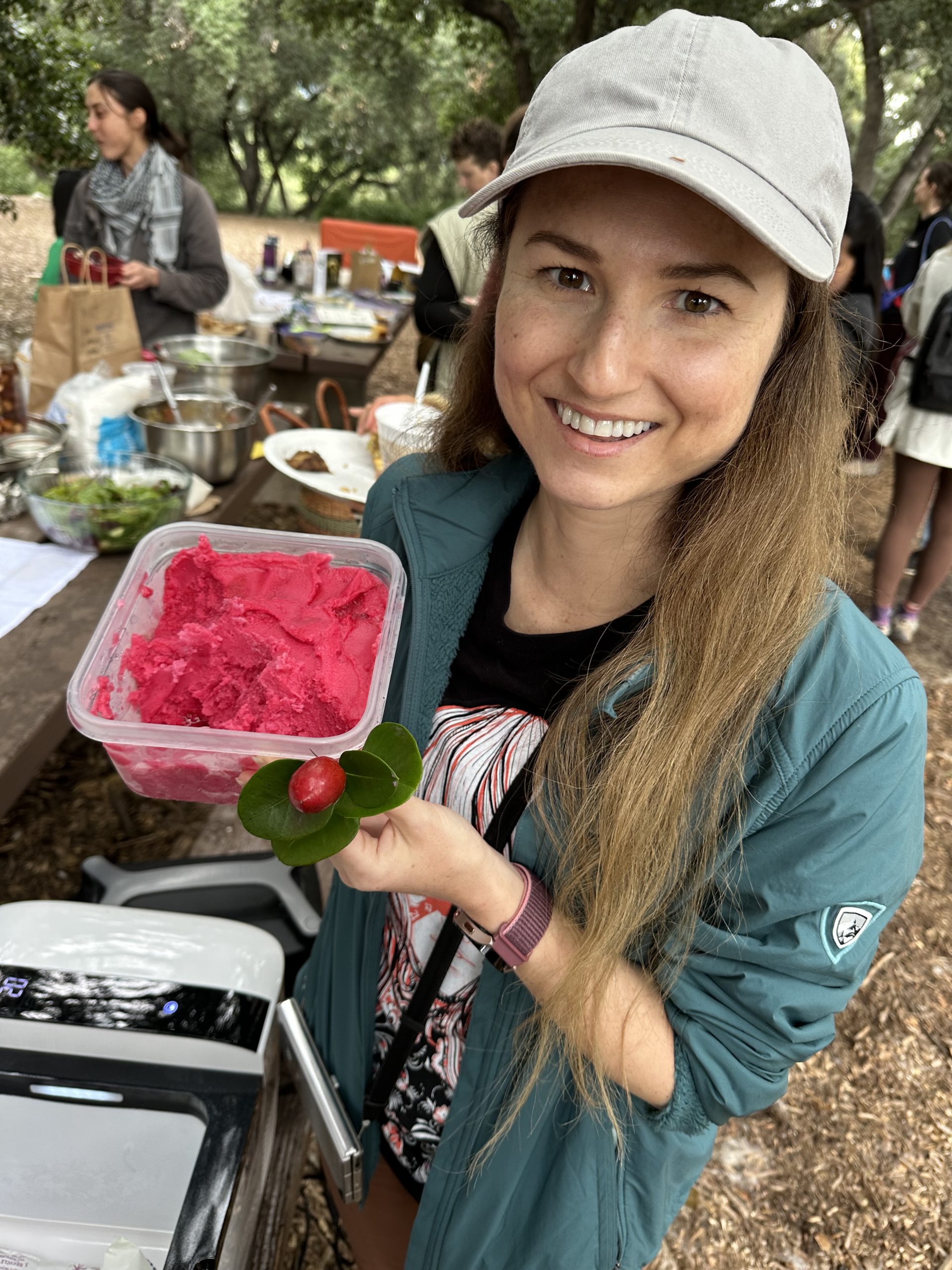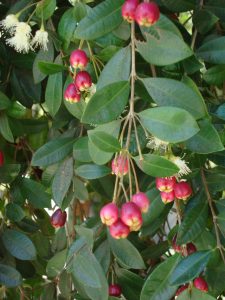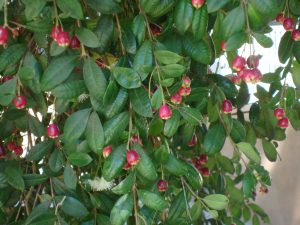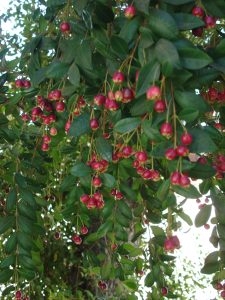Aka AUSTRALIAN BRUSH CHERRY or EUGENIA (Syzygium paniculatum)
By Christopher Nyerges [www.SchoolofSelf-Reliance.com]
Lilly pilly is a member of the Myrtle Family (Myrtaceae)
Description: The Lilly Pilly is an evergreen shrub that is typically manicured as a border hedge in urban yards. Left alone, it grows tall into a tree.
Uses: Fruit can be eaten
Habitats: Commonly used in landscaping as a hedge. Can be a tall tree.
Range: In the U.S., widely planted throughout the state. Found in Florida, some southern States, Hawaii.
Lilly pilly is a widespread hedge and bush tree, native to Eastern Australia.
According to Tim Low in his book, “Wild Food Plants of Australia,” “This was the first Australian fruit to be eaten by the Englishmen. Captain Cook gathered fruits at Botany Bay, and Joseph Banks wrote that ‘we eat with much pleasure, tho they had little to recommend them but a slight acid.’” Low adds that the fruits are often cultivated.
According to Jennifer Isaacs in “Bush Foods: Aboriginal Food and Herbal Medicine,” The pink and white varieties were popular Aboriginal food in the southern regions of Australia. Colonists and English settlers to Australia made these fruits into wine, jellies, and jams.
There are at least 1,000 species in the Syzygium genus, though only about half a dozen are called Lilly Pilly. In the U.S., we mostly find S. paniculatum, commonly called Australian brush cherry by gardeners. It’s used in yards and ornamental gardens, often to define borders. There are some areas in California where you will see the Lilly Pillies growing in the wild, and these were most likely survivors they were originally planted there and have simply survived.
Arborist Tim Snider said that people often think this is a native plant because it is so common. “It’s really very common,” said Snider, “and I like to eat the fruits raw. However, you can’t really make a meal from it.” Snider pointed out that there are some lilly pillies in the Pasadena area that are as tall as a two story building, “but normally you see them as bushes.”
According to botanist Dr. Leonid Enari, the flavor is bland and low in sugar, but definitely edible. He always recommended chilling them first.
In the 1960s, my brother and I would walk home from school along Woodbury Avenue in Altadena, and pass by a long hedgerow of the Lilly pilly bushes. We had no idea what it was called back then, but some of the older boys used to eat the fruits, so we did too. And since we didn’t get sick or die, we continued to eat the fruits as a snack whenever we walked by.
I recall when one of the parents of our school-mates told us to never eat these fruits since they were poisonous, but we’d already been eating them for a few years. We all just stifled our giggles.
The color of the ripe fruit is attractive – a bright magenta color – and the flavor is mildly-sweet, with a bit of tartness. The texture is strange, like wet Styrofoam, but tasty. Typically, children just chew on the fruit, suck the juice out, and spit out the seed.
The lilly pilly plants were brought into California from Australia, and soon because as widespread as the eucalyptus and acacia trees, also from Australia. They are popular among landscapers because they are easy to grow, are relatively drought-tolerant, and fill out quickly as hedges and border bushes.
Someone once served fresh Lilly Pilly fruits at a Natural Food gathering I attended. They were very large fruits, which had been chilled and lightly topped with honey. They were very good.
I have never tried drying these fruits or making jams with them, though they should make a flavorful jam or jelly and even a good juice.
At one of the Women’s Foraging pot luck gatherings organized by Bat Vardeh, one of her followers brought some lilly pilly sherbet that she had made in her kitchen. It had a beautiful color, and the taste and texture were incredible. Try as I did to get the recipe, I never succeeded, but was told to simply follow any sherbet recipe and substitute the lilly pillies for whatever fruit they ask for.
Sometime in the mid-1990s, an insect called the Eugenia psyllid worked its way through a large percentage of the Lilly Pilly bushes of Southern California causing the leaves to appear puckered up with lots of little bumps, and this was accompanied by a black sooty mold that formed on the honeydew that was excreted by the psyllids. This caused many of the Lilly Pillies to die off, up to 50% , according to some estimates. This caused professional gardeners a lot of extra work trying to save the old lilly pilly bushes. Many of the bushes that were ubiquitous no longer exist, but the bushes are still fairly common in Southern California.
I used to see larger fruits, bigger than an inch from top to bottom, though these days the berries all seem to be smaller, possibly as a function of less irrigation.
xxxxxxxxxxxxxxxxxxxxxxxxxxxxxxxxxxxxxxxx
BOTANY
Botanists have been working through the differences between the Eugenia and Syzygium genera, because they are very similar. Most of both of these are evergreen, and originated from Tropical regions. The Lilly Pilly discussed here was once classified as a Eugenia – which is why many gardeners still simply call it “Eugenia”- – though botanists now classify it as Syzygium.
Eugenia has about 1,000 species world-wide, with just a few from Australia.




